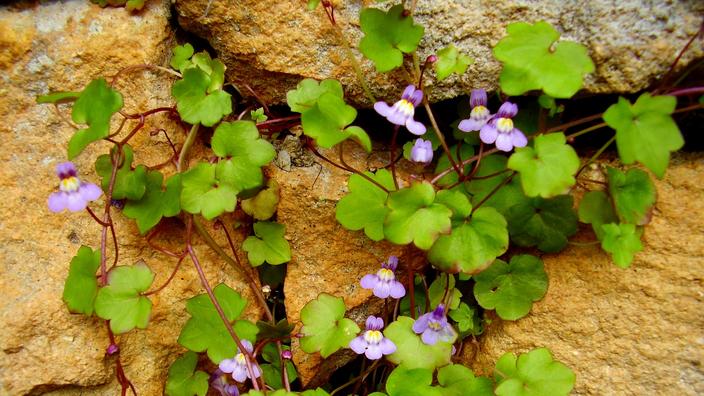Cymbalaria
, its Latin name
Cymbalaria
muralis
, is part of the Scrophulariaceae family, like foxglove, calceolarium or butterfly bush.
To discover
True or false: fight misconceptions about the garden
What is the origin of the wall cymbal?
Also called "
Ruine de Rome
" or "
flowering ivy
", this elegant little plant with
delicate flowers
is native to Europe and Western Asia.
Main types
: Alongside the wild type, there are several man-made varieties, or cultivars, such as
C. muralis
'Alba' with white flowers,
C. muralis
'Snow Wave' with cream-edged leaves and
C. muralis
' Globosa Roseum' with pretty pink petals. Note the existence of a similar species,
Cymbalaria aequitriloba
, smaller, which is distinguished by its hairy leaves.
Uses:
Cymbalaria
naturally
colonizes old walls, interstices in paving, the edge of terraces or scree.
But it can also be grown in suspension in association with other plants or used as a ground cover in the cool and shady part of the garden.
Read alsoWhat is a perennial plant?
What are the characteristics of the wall cymbal?
The wall cymbal is a small
perennial plant
with many more or less branched stems, 20 to 80 cm long, creeping or drooping, capable of rooting at each node.
Its small round and evergreen leaves, bright green, more or less bordered with purple, dress up walls and stones nicely.
The purplish-mauve flowers, with yellow throats, in the shape of miniature snapdragons, are born in their axils.
About 1 cm wide, they have two lips and a nectariferous spur that attracts pollinating insects.
Once fertilized, the peduncle moves the fruit towards the dark, looking for a possible crack where the seeds can germinate more easily.
Nature, once again, does things well!
Flowering period:
Several months from April to September, which is very significant.
Hardiness:
Withstands cold down to -19°C.
Read alsoGarden: how to prevent your plants from freezing
How to cultivate the wall cymbal?
Level of difficulty:
Very easy.
Exposure:
Shade or partial shade, preferably sheltered from direct afternoon sun, especially in summer.
Soil:
Undemanding, the cymbal will appreciate ordinary, even poor soil, provided it is well drained.
Sowing/planting:
Propagation does not pose any particular problem.
It is carried out in three ways: by division of the clumps in spring, by layering [mm2] or by surface sowing in spring.
But you will have to be patient because the seeds need three months at 20°C to germinate.
Advantage: as soon as it flowers and scatters its seeds, it reseeds itself naturally every year in your garden.
Read alsoHow to buy local and seasonal flowers?
Cultivation:
An easy plant,
Cymbalaria muralis
requires very little care once it is well established.
Be careful, when transplanting, not to damage the roots and stems, tender and fragile, of the young seedlings.
Diseases and parasites:
None to date.
Sheet written by Jean-Marie Souil, Perennial Plants section









